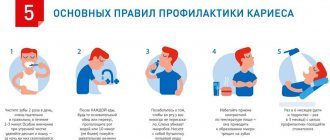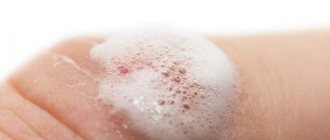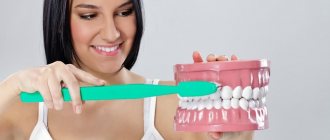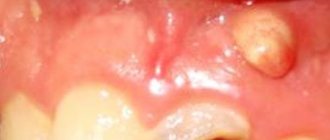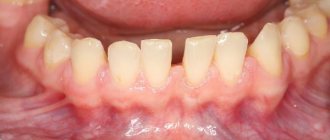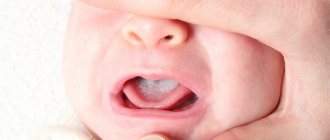How teeth erupt
The eruption of baby teeth is normal, but if the child’s condition is too severe, you should consult a dentist.
There may be deviations from the norm. There are also standards regarding the order of teething. However, there are individual characteristics of the body, so minor discrepancies with the standards are not considered pathology.
Teething occurs in the following order:
- incisors;
- premolars;
- fangs;
- molars.
Babies begin to erupt their first teeth at 6 months, but may appear earlier. By 12 months, 6–10 crowns are the norm. By the age of three, young children's dentition consists of 10 upper and 10 lower teeth.
What to do about bad breath?
Quite often people suffer from bad breath. Many people struggle with this phenomenon. But overcoming the smell can be difficult. After all, disguising it is one thing, but getting rid of it is a completely different matter. In order to get rid of bad breath, you must first discover its cause. Most often, bad breath is caused by microbes that live in the oral cavity. To defeat them, it is not necessary to immediately go to the dentist and undergo complex treatment. Try the tips below.
What are the symptoms of teething?
If a child’s first tooth does not come out by 5–6 months, then parents, as a rule, are already expecting its appearance and monitoring the baby’s condition. Often it is the first teeth that are painful.
During this period, children are overly capricious and cry a lot. Teething can be distinguished from another pathology in a child who, due to his age, cannot speak, by the accompanying symptoms.
Associated symptoms of teething in a child:
- the gums swell and the mucous membrane swells in the place where the tooth appears;
- salivation increases;
- body temperature can be from 37 to 39 degrees;
- sleep is disturbed;
- no appetite;
- stool is disrupted (diarrhea is more common);
- the throat turns red;
- nasal congestion appears;
- there may be watery nasal discharge;
- regurgitation becomes more frequent;
- an allergic reaction is possible.
Due to pain and itching in the gums, babies often put something in their mouth to suck or chew. Many parents observe such a habit as pulling and biting the pacifier or mother's nipple.
All of the listed signs of teething in a child are individual. Some babies do not experience any discomfort and parents notice the erupted tooth only after it appears.
Causes of gum inflammation
The causes of inflammatory processes in the gums can be very different. Their manifestations in the oral cavity can also be different. These may be ulcers on the cheeks, a red rash on the palate in adults, a taste of pus in the mouth, a bubble or blister on the gum, sores in the mouth, a sore tooth, a hole or a hard growth on the gum. Long-term inflammation of the mucous membranes can degenerate into an abscess on the gums. In this case, the wound in the mouth is most often painful and bleeds.
Any inflammatory process of the mucous membranes of the oral cavity is aggravated by the microflora of the oral cavity. Therefore, treatment of gums and strengthening of teeth is carried out using antiseptics and antibiotics.
Chief physician Salatsky Dmitry Nikolaevich
Sign up for a free consultation
+7
Eruption of molars
The eruption of molars in children is somewhat different. Already “adult” teeth do not cause such intense symptoms. This may be due to the fact that the child’s pain threshold has already increased significantly. Another advantage is that the permanent tooth erupts through the gum, which has not yet completely healed after the baby tooth has fallen out.
The process of replacing baby teeth with permanent ones occurs at the age of 5–7 years. This happens as follows. The rudiments of molars begin to form inside the gums and gradually “push” the milk teeth, the roots of which by this time are already resolving. When temporary crowns fall out, they are replaced with permanent ones.
The pattern of eruption of permanent teeth in children corresponds to the order of growth and loss of baby teeth. The first teeth to fall out are the central incisors, the lateral incisors, and then the molars. Possible deviation from the norm. The correspondence between the eruption of primary and permanent teeth is explained by the “life” of the roots of the first teeth. The bite changes completely only at 10–14 years of age. By this age, the child should have 28 teeth. The remaining 4 are eights (wisdom teeth) and they all grow individually.
Recommendations for rinsing the mouth after tooth extraction
If it happened that you had to remove a tooth, then you should know what actions should be taken in the future, namely, rinsing the mouth after tooth extraction .
Never decide on your own which solutions should be used to rinse the mouth after tooth extraction. Consult your doctor first! Find out about the possible start of rinsing, the frequency, medications and strictly follow them.
Remember that after tooth extraction:
- It is forbidden to eat during the first 2-3 hours;
- You cannot create increased physical activity for the body as a whole;
- For 2 days you must give up cigarettes and alcohol;
- Only short-term exposure to the sun is allowed;
- You should avoid taking a hot shower or visiting a sauna.
What assistance should be provided during teething?
A dentist can advise you on how to provide correct and effective assistance when teething in children. If there are signs of the appearance of the first teeth, it is recommended to show the baby to a specialist.
Simple Methods
Popular methods for relieving itching and pain in young children that parents should use.
- Gum massage. Hands are washed well. After this, the parent makes pressing and rubbing movements with his finger at the site of gum swelling. You can replace finger massage with a silicone brush, which is pre-disinfected.
- Cooling. Place the teether in the freezer for 10–15 minutes and then give it to the baby. You can also rub the toy along your child’s gums yourself. Cold constricts blood vessels, eliminates sensitivity, thereby reducing pain.
Both methods should be approached with caution to avoid injury or hypothermia of the gums.
Pharmacy products
To eliminate itching and pain, you can purchase a special product at the pharmacy. These can be powders for oral administration, or local agents that have an anesthetic effect.
Local pharmacies:
- Kalgel;
- Kamistad;
- Holisal;
- and others.
The use of any product is permissible only after consultation with a dentist and after a preliminary allergy test.
To reduce the temperature, it is recommended to give the child Nurofen. It is also possible to apply the syrup locally to the swollen area of the gum.
Remedies that can be used to dull the pain before meeting the dentist:
Rinsing.
These can be either home remedies, prepared with your own hands, or medicinal ones. Homemade ones include: a warm solution of water with soda, a decoction of chamomile, sage, calendula or oak bark, which can be used to rinse the tooth several times a day (on average three to five times), or you can simply keep it on the sore side.
Medicines
- ready-made concentrated alcohol solution, mixture of herbs - stomatophyte. Rinses such as Colgate, Blend - a - Med are additional oral hygiene and do not have an analgesic effect. There are also anti-inflammatory drugs such as Nice, Ibuprofen, Xefocam. It should be borne in mind that taking a very large amount of painkillers when visiting a doctor reduces sensitivity to local anesthetics.
You have bleeding gums - what to do?
Alena Kravchenko, especially for the A-Plomb clinic
|
10/15/2018
|
Questions - Answers
Many people are concerned about the problem of bleeding gums. Gums can bleed both as a result of the disease and as a result of mechanical impact on them, for example, with an ordinary brush for cleaning the incisors.
Gum hemophilia is the most common symptom of gum disease. If your gums are bleeding constantly, it cannot be ignored. At the moment when the gums begin to bleed, they are maximally open to other dangerous bacteria.
If you do not come to your senses in time and do not start treatment at the dentist, ordinary bleeding from the gums can develop into a more serious disease, for example, periodontitis.
Symptoms of the onset of gum disease include:
— Gums that bleed when eating, and gums that lag behind the tooth.
- Teeth that suddenly begin to loosen, and a persistent unpleasant odor that comes from the oral cavity.
— As soon as a person begins to notice these symptoms, he needs to urgently consult a dentist.
Gums are bleeding - what are the reasons?
If your gums bleed while brushing your teeth, this is an indicator that an inflammatory process is occurring in the oral cavity.
Bleeding gums can indicate not only that a person does not take good care of their teeth, but also that they have autoimmune diseases.
External causes of bleeding gums
- Often, smokers' gums begin to bleed due to their interaction with tobacco and other smoking mixtures.
— A poorly secured denture can also cause mechanical damage to the gums.
— Brushing your teeth too quickly and too harshly with aggressive toothpastes and rough-bristled brushes can easily cause your gums to bleed. To get rid of the consequences, you need to completely reconsider your teeth brushing technique. Dentists recommend starting to brush your teeth from the gums to the tips of the teeth. A toothbrush should be chosen with softer bristles, but not too soft.
— Tartar can also harm your gums, so if you have the opportunity to have the tartar cleaned at the dentist, do so.
Internal causes of bleeding gums
— Taking some doctor's medications can cause your gums to bleed.
— Pregnant women, whose hormonal levels change during pregnancy, are also susceptible to gum disease.
— Lack of vitamin C and K, which help blood clot in the human body, is also one of the causes of gum hemophilia.
If the problem is not noticed in time, it will grow and can reach such a scale that the patient simply loses his teeth.
Gums are bleeding - ten tips on what to do at home
Having found out the causes of gum inflammation, we can return to the problem of treating bleeding gums. If the blood discharge is small, you can turn to home treatment. With therapy at home, a positive result can be achieved through an integrated approach to eliminating the problem.
You can try different methods, because one person may be helped by something that did not help the second patient.
Methods can be like:
— Treatment of the inflammatory process in the oral cavity with the help of pharmaceutical medications.
— Use of specialized anti-inflammatory gels.
— Treatment using alternative medicine.
- Switching to proper nutrition or diet.
— Particular attention to oral hygiene.
— Going to the dentist, as needed.
— Use of professional toothpastes, powders and threads that are recommended by dentists.
— Rinsing the mouth with various traditional and non-traditional means.
— Taking a complex of vitamins that help restore gums.
— Exclusion of tobacco and other smoking mixtures, as well as seeds and food products that can mechanically damage the gums.
If you decide to seriously address the issue of bleeding gums, we recommend that you turn your attention to gels for the treatment of the oral cavity. In pharmacies in your city you can buy drugs called “Cholisal”, “Kamistad” and “Acepta”. These gels are suitable for preventing the problem of bleeding gums, they cool them, relieve pain and inflammation.
In any case, before using them, it is recommended to visit your dentist for advice. Only after examining the incisors and gums will the doctor be able to decide on prescribing the toothpaste and other medications that are suitable for you.
Folk remedies for bleeding gums
If your gums are bleeding, there are many folk remedies that will help cope with this disease.
Oak bark
This remedy can eliminate the problem of bleeding gums. It is enough to regularly rinse your mouth with a decoction based on oak bark; it can be bought at any pharmacy in your city.
For 0.5 liters of water you need to take 2 tbsp. oak bark, put the mixture on fire and boil for about 10 minutes. After the decoction is ready, it needs to be strained. Only after this can you start rinsing your mouth. Two or three times a day, half a glass of oak bark decoction, here is a recipe for healthy gums.
Sea salt
At home, you can prepare rinses based on sea salt. To do this, you need to dilute 1 tablespoon of salt in a glass of boiled water. It is enough to rinse your mouth several times throughout the day.
Many people rub pure sea salt into the gum itself. It relieves inflammation, strengthens the gums themselves and stops bleeding.
St. John's wort
The inflammatory process in the gums can be relieved using a decoction of St. John's wort. Pour 1 spoon of herb with a glass of boiling water and let it brew for 30-40 minutes. After this, start rinsing.
Aloe
Almost every home has a plant like aloe. Not many people know that the juice of this flower can help cure many diseases. To get rid of gum inflammation, you need to pick one aloe leaf, clear it of thorns, cut it in half and apply it to the sore gums. To feel the desired relief, 5-7 such procedures are enough. Agree, this is truly a magical plant.
Baking soda
Most of the time, rinsing with baking soda helps. Baking soda is good for relieving gum inflammation. For 200 ml. warm water will require 1 teaspoon of soda.
Plantain
Plantain can treat inflammation. In summer, it is very easy to prepare the leaves of this plant and make a healing infusion from them. For this you will need fresh plantain juice. During winter, an infusion can be prepared from previously dried leaves.
If you wash the plantain leaf well, you can even chew it whole and then spit it out as a preventive measure for gums. After three days, you will already notice how your gums have stopped bleeding and began to look much healthier.
Chamomile
This is a classic remedy for fatigue, irritability, and now also for bleeding gums. In order to relieve inflammation in the oral cavity, chamomile is often mixed with calendula. The infusion is prepared by taking one spoon each of chamomile and calendula flowers, pouring a glass of boiling water over them and leaving for about half an hour.
Calendula
The infusion can be made separately, and then alternate chamomile with calendula every other day.
Gums bleed during pregnancy - what to do
Every girl who has experienced childbirth has most likely observed how unstable her emotional state was. Many girls behave like heroines of soap operas, their behavior is eccentric and capricious, while women in labor are prone to frequent tears. So bleeding gums should not become another stress for a pregnant woman.
And bleeding in the gums is just the first sign that inflammatory processes are beginning to occur in the mouth, which are sometimes, unfortunately, irreversible. If you do not pay the necessary attention to this problem in time, then gingivitis, which is common during pregnancy, can take on a more acute form.
Each infection in the mother’s body can affect the child’s health. Pregnant representatives of the fairer sex develop diseases much more quickly than those who do not carry a baby under their hearts. Unfortunately, if a woman does not cure bleeding gums in time, this can also affect the baby.
Doctors have long proven that if the disease “starts”, the child will appear with little weight. There is every chance of more difficult consequences, for example, premature birth and fetal loss.
Modern medicine makes it possible for expectant mothers to treat emerging health problems without harm to the child. The main thing is to remember that when visiting the dentist, you must notify him that you are expecting a child.
Ways to solve the problem of bleeding gums during pregnancy:
- Healthy diet.
— Integral consumption of foods containing vitamins C, B, K, E.
— Adding a variety of spices to the diet, which will stop the increase in the number of microbes in the oral cavity.
— High-quality dental therapy.
— Treatment of incisors and gums at home using dental powders, mouthwashes, antiseptics and tablets
— Also, one should not ignore the unconventional methods described above.
Pregnant representatives of the fairer sex, if there is a problem, are recommended to go to the dentist at least once a month. Doctors must monitor the patient’s health to prevent the spread of germs.
Gums bleed when brushing teeth - how to treat
Inflammatory sensations in the gums in themselves are unpleasant. It is doubly disgusting if bleeding occurs due to such a process. When we brush our teeth, there is also the possibility of mechanical damage to the gums. This is why, most often, healthy people suddenly begin to ooze blood from their gums.
How do we use to clean our teeth? First of all, this happens in a hurry. Few of us stand for half an hour at the mirror in the bathroom and carefully clean each incisor with a toothbrush.
Few people use dental floss exactly after eating and, of course, not everyone rinses their mouth with various means: both pharmaceutical and folk. Little by little, bacteria accumulate on the teeth near the gums, and the process of inflammation begins.
Touching on the topic of proper brushing of teeth, it should be noted that there are certain rules according to which you need to clean your teeth from recent food debris and potential fertile ground for the proliferation of microbes. By sticking to them, you may be able to get rid of bleeding gums forever.
The correct position of the brush for cleaning should be such that the bristles move from the gum to the tip of the tooth. If you brush like this, the brush will never damage your gums.
If the gums have been damaged, you need to stop brushing your teeth and rinse them with a special product, and then go to the doctor as quickly as possible.
You can also damage your gums with a low-quality toothbrush and its rough bristles. Having such a brush, whether he wants it or not, will harm his gums.
If you find such a brush in your bathroom, replace it immediately. It is important to pay attention to the product you use to brush your teeth; it is best to buy it after consulting with your doctor before doing so.
You can treat gums using the methods that were described earlier. In alternative medicine, there are many decoctions and tinctures based on medicinal herbs, such as chamomile, plantain, calendula, aloe, oak bark, which will relieve inflammation, stop bleeding and temporarily soothe toothache if it appears.
If your gums are bleeding and you have bad breath
Bleeding from the gums can be preceded by a number of factors, for example:
— Diseases of the internal oral cavity, damage to the gums, as one of the possible causes.
- Reduced blood clotting throughout the body.
Common illnesses that may cause bleeding:
- Hemophilia, which is transmitted from mother to child.
— Skin diseases and allergic reactions.
- Papilloma or influenza virus.
If you notice such bleeding during the period of brushing your teeth, or at any other time, you should definitely seek medical help.
A sharp “smell” from the mouth is medically called halitosis.
There are three types of this problem:
— People around you may hear a stale odor from your mouth, which is a consequence of digestive disorders or illness.
- There is barely a smell coming from your mouth, this usually happens with erroneous halitosis;
- You experience a real phobia because of what appears to be bad breath, but in fact there is no smell at all, and this problem is called halitophobia.
A visit to the doctor will help you determine exactly your problem.
If you do have an unpleasant odor coming from your mouth, this indicates that you may not brush your teeth often.
Bacteria that gradually accumulate on the teeth and cheeks begin to release hydrogen sulfide and it is because of it that the air exhaled by a person initially smells bad.
To prevent this from happening, you should brush your teeth and rinse them more often, and the problem will disappear.
In people who do not take care of their teeth at all, bad odor occurs due to problems with the teeth or gums themselves.
Halitosis can be caused by various diseases, such as caries, stomatitis, odor can be caused by wisdom teeth, and sometimes even dental crowns become pathogens.
All this happens because food particles begin to stagnate in the mouth, remaining there for a long time. To prevent this from happening, monitor the condition of your teeth and visit the dentist regularly.
Tags:
dentistry
|
Previous post
Next post
Write a comment

